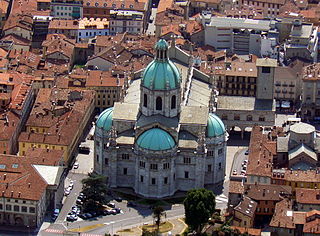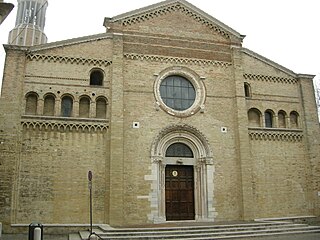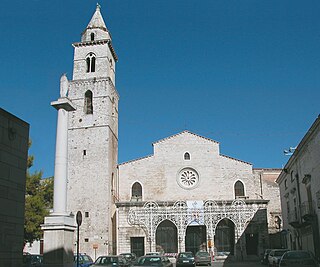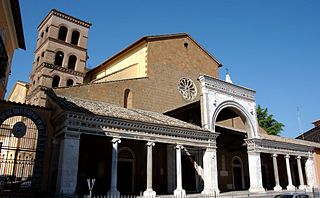
The Diocese of Ajaccio is a Latin Church ecclesiastical jurisdiction or diocese of the Catholic Church in France. The diocese comprises the whole of the island of Corsica.

The Archdiocese of Amalfi-Cava de' Tirreni is an archdiocese of the Latin Church of the Catholic Church, with its episcopal see at Amalfi, not far from Naples. It was named Archdiocese of Amalfi until parts of the Diocese of Cava e Sarno were merged with it on September 30, 1986.

The Roman Catholic diocese of Ferentino existed until 1986, when it was united into the new diocese of Frosinone-Veroli-Ferentino.

The Diocese of Como is a Latin Church ecclesiastical jurisdiction or diocese of the Catholic Church in northern Italy. It was established in the Fourth Century. It is a suffragan diocese in the ecclesiastical province of the metropolitan Archdiocese of Milan. The Bishop of Como's cathedra is in the Como Cathedral.

The Diocese of Tivoli is a Latin Church ecclesiastical territory or diocese of the Catholic Church in Latium, Italy, which has existed since the 2nd century. In 2002 territory was added to it from the Territorial Abbey of Subiaco. The diocese is immediately exempt to the Holy See.

The Diocese of Foligno is a Latin Church ecclesiastical territory or diocese of the Catholic Church in Umbria, Italy. It is a suffragan diocese in the ecclesiastical province of the metropolitan Archdiocese of Perugia-Città della Pieve.

The Diocese of Fano-Fossombrone-Cagli-Pergola is a Latin diocese of the Catholic Church in Italy, created in 1986, when the historical Diocese of Fano was united to the Diocese of Cagli e Pergola and the Diocese of Fossombrone. It is a suffragan of the Archdiocese of Pesaro.
The Catholic diocese of Sarsina was a Roman Catholic ecclesiastical territory in Emilia-Romagna, northern Italy, seated in Sarsina, in the province of Forlì, some 32 km south-southwest of Cesena. The diocese was founded in the 5th century, and was suffragan (subordinate) to the archbishop of Ravenna. The diocese existed until 1986, when it was united with the diocese of Cesena.

The diocese of Teano-Calvi is a Latin diocese of the Catholic Church in Campania, southern Italy, created in 1986. It is a suffragan of the Archdiocese of Naples. The historic Diocese of Teano and diocese of Calvi Risorta were united in 1818, forming the diocese of Calvi e Teano.

The Diocese of San Severo is a Latin diocese of the Catholic Church in Apulia. It is a suffragan of the Archdiocese of Foggia-Bovino.

The Diocese of Latina-Terracina-Sezze-Priverno is a Latin Church ecclesiastical territory or diocese of the Catholic Church in Lazio, Italy. It was established under this name in 1986. It is the continuation of the Diocese of Terracina, Priverno e Sezze, whose existence was confirmed by Pope Honorius III in 1217, as a joining of the Diocese of Terracina with the Diocese of Priverno and the Diocese of Sezze under a single bishop. It is immediately exempt to the Holy See.

The Diocese of Andria is a Latin diocese of the Catholic Church in Apulia, seated at Andria Cathedral which is built over a church dedicated to St. Peter, about ten miles southwest of Trani. It is a suffragan of the archdiocese of Bari-Bitonto. The diocese has 39 parishes, with one priest for every 1,573 Catholics.

The Diocese of Anagni-Alatri is a Latin Church ecclesiastical territory or diocese of the Catholic Church in Lazio, Italy. It has existed in its current form since 1986. In that year the Diocese of Alatri was united to the historical Diocese of Anagni. The diocese is immediately exempt to the Holy See.

The Diocese of Civita Castellana is a Latin Church ecclesiastical territory or diocese of the Catholic Church in Latium, central Italy. It has existed in the current form since 1986, when the Diocese of Nepi e Sutri was united into the Diocese of Civita Castellana, Orte e Gallese. The Diocese of Gallese had been added to the Dioceses of Civita Castellana and Orte in 1805. The name of the diocese was shortened in 1991, in accordance with Vatican policies. The diocese of Civita Castellana is immediately exempt to the Holy See.

The Diocese of San Benedetto del Tronto-Ripatransone-Montalto is a Latin diocese of the Catholic Church in the Marche. It has existed in its current form since 1986. In that year the Diocese of Montalto was united into the Diocese of Ripatransone-San Benedetto del Tronto, which was the renamed historical Diocese of Ripatransone. The Roman Catholic Diocese of San Benedetto del Tronto-Ripatransone-Montalto has been a suffragan see of the Roman Catholic Archdiocese of Fermo since 1680.
The Italian Catholic diocese of Lacedonia, a suffragan of the archdiocese of Benevento in Campania, existed until 1986 when incorporated into the reorganized Roman Catholic Diocese of Ariano Irpino-Lacedonia.
The Diocese of Acerno was a Roman Catholic diocese based in Acerno, a distance of 68 km (42 mi.) from Naples in southern Italy, with the bishop's seat in Acerno Cathedral. Created in the 11th century, in 1818, the diocese was granted in perpetual administratorship to the archbishops of Salerno. In the reorganization of ecclesiastical provinces in 1986, Acerno was suppressed, to create the Archdiocese of Salerno-Campagna-Acerno.

The Diocese of Accia was a Roman Catholic bishopric on the island of Corsica. It is now a titular diocese. The diocese was located in the town of Accia in the interior region of Haute-Corse, which was destroyed and from which only some ruins remain. Established in 824 AD it was merged with the Diocese of Mariana in 1554. In 1570 the Bishop of Mariana and Accia moved his seat to Bastia.
The Diocese of Venafro was a Roman Catholic diocese in Italy, located in Venafro, province of Isernia, region of Molise in the ecclesiastical province of Capua. In 1852, the dioceses of Isernia and Venafro were united under the governance of one and the same bishop, aeque personaliter. The diocese of Venafro was permanently suppressed on 30 September 1986.

The Diocese of Montalcino was a Roman Catholic diocese located in the town of Montalcino to the west of Pienza, close to the Crete Senesi in Val d'Orcia in Tuscany, Italy. In 1986, it was suppressed and united with the Diocese of Colle di Val d'Elsa and the Archdiocese of Siena to form the Archdiocese of Siena-Colle di Val d'Elsa-Montalcino.


















